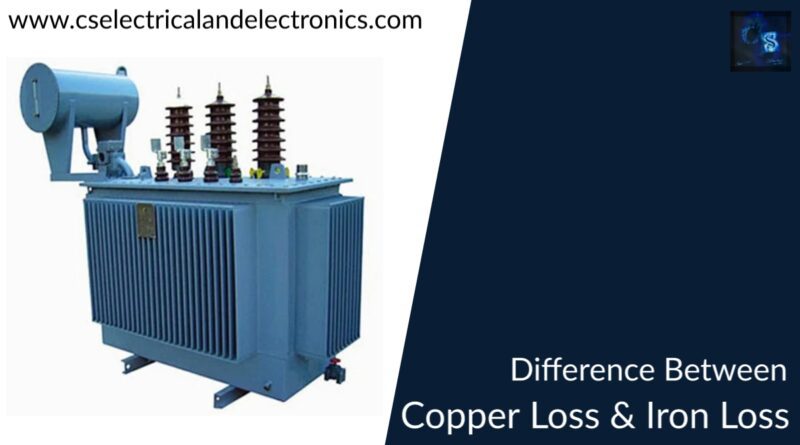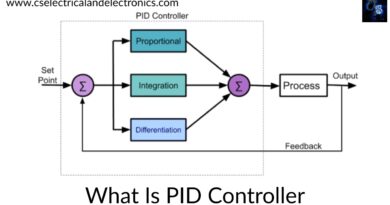Difference Between Copper Loss And Iron Loss In Transformer
Hello guys, welcome back to our blog. In this article, we will discuss the difference between copper loss and iron loss in a transformer, what is copper loss in a transformer, and what is iron loss in a transformer.
If you have any electrical, electronics, and computer science doubts, then ask questions. You can also catch me us Instagram – CS Electrical & Electronics.
Also, read:
- Difference Between 2G, 3G, 4G, 5G Technology, Benefits, Drawbacks.
- Difference Between Cascaded H-Bridge, Flying capacitors, Diode Clamped multilevel inverter.
- Difference Between PI, PID, Fuzzy Logic Controller, Disadvantages.
Difference Between Copper Loss And Iron Loss
Mechanical loss in the transformer is generally ignored because the electrical transformer is a static device. In most cases, we just examine electrical losses in transformers. Any machine’s loss is defined as the difference between its input and output power.
Part of the input power is used to correct core losses in the transformer, such as Hysteresis loss in the transformer and Eddy current loss in the transformer core, and some of the input power is lost as (I^2)*R loss and dissipated as heat in the primary and secondary windings because these windings have some internal resistance in them.
The first is known as transformer core loss or iron loss, and the second is known as transformer ohmic loss or copper loss. Another type of loss in transformers is stray loss, which happens when stray fluxes come into contact with the mechanical structure and winding conductors.
Copper Loss in Transformer:-
The heat created by electrical currents in the conductors of transformer windings is referred to as this. It is an energy transfer that occurs as a result of induced currents in nearby components. The resistance of the wire in the primary and secondary windings, as well as the current flowing through them, cause copper losses.
These losses can be minimized by utilizing wire with a wide cross-sectional area when making coils. Copper loss is (I^2)*R loss, with (I1^2)*R1 loss on the primary side and (I2^2)*R2 loss on the secondary side, where I1 and I2 are the primary and secondary currents of the transformer and R1 and R2 are the primary and secondary winding resistances.
Copper loss in transformers varies with load because both primary and secondary currents are dependent on the load. The transformer has two windings: a primary winding and a secondary winding. The losses caused by the winding resistance are known as copper losses. Copper loss is often referred to as (I^2)*R or a loss. If R1 is the primary winding resistance and R2 is the secondary winding resistance,
Total copper loss in transformer = (I1^2) R1 + (I2^2) R2
Copper loss is precisely proportional to the square of the load current, as shown by the equation above. It means that as the load current changes, so do the copper loss. As a result, this loss is categorized as a variable loss. The energy expended by resistance in the wire used to wind a coil is referred to as copper loss.
In 99.9% of cases, this wire will be composed of copper, which has a resistance of 1.73 10–8 m at 20°C. Coils, on the other hand, must frequently operate above room temperature and will, in any event, be heated by operational losses. These losses fluctuated depending on the load and are referred to as variable losses. Copper losses are proportional to the load current squared.
Iron Losses in Transformer:-
The amount of iron lost in a transformer is determined by the core. To magnetize the core, the transformer needs to pull a particular amount of electricity. The only approach to adjust or lessen iron loss is to change the basic design. Iron loss is reduced when there is less iron (ferromagnetic material with low reluctance and high permeability).
This is the loss that occurs as a result of the alternating flux in the transformer’s core. Because the loss happens in the core, iron loss is sometimes referred to as core loss. Eddy current loss and hysteresis loss are two different types of iron losses. Hysteresis loss in transformers is caused by magnetization reversal in the transformer core.
The amount of loss is determined by the volume and quality of iron, the frequency of magnetic reversals, and the flux density value. The Steinmetz formula can be used to determine it:
Wh= ηBmax^1.6fV (watts)
where,
η = Steinmetz hysteresis constant
V = volume of the core in m3
Hysteresis losses grow with frequency, and they’re worst in materials with a lot of retentivity. Once magnetized, these materials tend to keep their magnetism. It takes more energy to demagnetize them than it does to demagnetize those with poor retentivity. Eddy current loss in transformers: A transformer’s primary winding receives AC, which creates an alternating magnetizing flux.
This flux causes induced emf in the secondary winding when it connects with it. However, some of this flux is absorbed by other conducting parts such as the steel core, iron body, or transformer, resulting in induced emf and a small circulating current in those elements. Eddy current is the name given to this type of current. Some energy will be wasted in the form of heat as a result of these eddy currents.
This difficulty is largely solved by using very thin laminates for the core. Each lamination has an insulating layer on both sides to prevent current from flowing between them. At the same time, the coating permits the flux lines to flow freely. The resistance of the core is substantially increased, and the amplitude of the eddy currents is significantly reduced, as a result of this process.
Other than ensuring that the transformer is working within its specifications, it is little the maintenance electrician can do to prevent transformer losses. Engineers and manufacturers have created extremely efficient devices.
To preserve this high efficiency, the electrician should handle transformers with caution when installing them. All fasteners should be tightened during routine maintenance procedures, and the installation should be kept clean.
I hope this article “Difference Between Copper Loss And Iron Loss” may help you all a lot. Thank you for reading.
Also, read:
- 10 Tips To Maintain Battery For Long Life, Battery Maintainance
- 10 Tips To Save Electricity Bills, Save Money By Saving Electricity
- 100 (AI) Artificial Intelligence Applications In The Automotive Industry
- 100 + Electrical Engineering Projects For Students, Engineers
- 1000+ Control System Quiz, Top MCQ On Control System
- 1000+ Electrical Machines Quiz, Top MCQs On Electrical Machines
- 1000+ MATLAB Simulink Projects For MTech, Engineering Students
- 50 Tips To Save Electricity At Home, Shop, Industry, Office
Author Profile
- Chetu
- Interest's ~ Engineering | Entrepreneurship | Politics | History | Travelling | Content Writing | Technology | Cooking
Latest entries
 All PostsApril 19, 2024What Is Vector CANoe Tool, Why It Is Used In The Automotive Industry
All PostsApril 19, 2024What Is Vector CANoe Tool, Why It Is Used In The Automotive Industry All PostsApril 13, 2024What Is TCM, Transmission Control Module, Working, Purpose,
All PostsApril 13, 2024What Is TCM, Transmission Control Module, Working, Purpose, All PostsApril 12, 2024Top 100 HiL hardware in loop Interview Questions With Answers For Engineers
All PostsApril 12, 2024Top 100 HiL hardware in loop Interview Questions With Answers For Engineers All PostsMarch 22, 2024Driver Monitoring Systems In Vehicles, Working, Driver Sleepy Alert
All PostsMarch 22, 2024Driver Monitoring Systems In Vehicles, Working, Driver Sleepy Alert









Nice
Awesome blog.
Online training